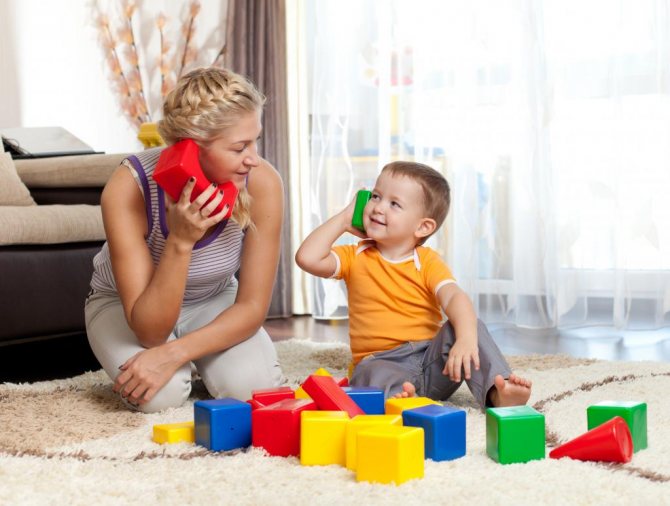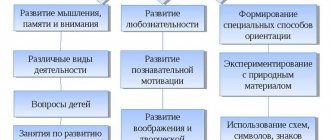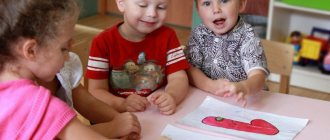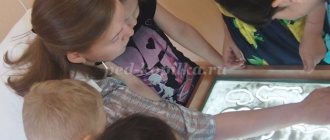MAGAZINE Preschooler.RF
BASICS OF OBJECT AND GAME ACTIVITY IN PRESCHOOL CHILDRENSubject activity is the leading activity of early childhood. Important new developments in early childhood include the child’s mastery of objective activities. Its prerequisites were formed in infancy.
The transition to object-based activity is associated with the development of a new attitude in the preschooler to the world of objects. Objects begin to appear to him not only as objects convenient for manipulation, but also as things that have a specific purpose and a specific way of use. The discovery of the purpose of objects distinguishes the object-based activity of a young child from the manipulative activity of an infant. The functions of things and objects are revealed to the child by an adult. It is he, the adult, who can provide knowledge about the purpose of objects and show techniques for their use, participating in the child’s activities as an organizer, assistant and senior partner.
An important role in the mastery of objective activity is play activity, which contributes to the fact that objective activity acquires leading status at an early age.
One of these common interpretations is the definition of the psychological concept of “activity” through the concept of “activity” . Since activity and objective activity (as we will try to analyze and prove in further research) are completely irreducible and not deducible from each other, realities and categories, but, at the same time, in psychological works are constantly connected and interdependent, we believe it is necessary to show them meaningful difference and, thereby, justify the limitations of activity and the prospects of substantive activity.
According to the periodization of mental development existing in Russian psychology, objective activity is leading at an early age. In the process of this activity, mastery of socially developed ways of acting with objects occurs.
Tool actions are formed in children gradually; mastering them requires certain efforts from children, since it presupposes a very specific, strictly fixed way of using objects.
Object-tool activity is leading in early childhood, ensuring the development of all aspects of the child’s life.
The influence of objective activity on the mental development of a child. Objective activity contributes to the development of mental processes.
Objective activity also determines the content of the child’s communication with adults.
Within the framework of objective activity, a new type of activity is being formed - a procedural game. The assimilation of socially developed ways of acting with objects is included in the system of human relations, which the child begins to understand in the course of real object-practical interaction with adults.
For children of primary preschool age, completing game tasks brings great pleasure. While playing, the child practices various actions. With the help of adults, he masters new, more complex movements.
At early preschool age, the requirement for mandatory targeted education of motor (physical) qualities is not yet put forward. However, changing game situations and game rules force a small child to move with greater speed in order to catch up with someone, or to quickly hide in a pre-designated place (house, nest) so as not to be caught, deftly overcome elementary obstacles (climb under a rope, without touching them, run between the pins without knocking over any, be sure to run to a certain place, etc.).
Thus, already in early preschool age, outdoor games are a means not only for the development of movements, but also for developing such qualities as dexterity, speed, and endurance.
Outdoor games create an additional opportunity for teacher to communicate with children. The teacher tells and explains to the children the content of the games and their rules. Kids remember new words, their meaning, and learn to act in accordance with instructions.
The activity of children in games depends on a number of conditions: the content of the game, the nature and intensity of the movements in it, the organization and methodology of its implementation, as well as the preparedness of the children.
In the process of play activities, the child acquires communication skills. He learns to take initiative, coordinate his actions, allowing him to maintain communication with his peers. In the future, gaming activities provoke longer communication. In the process of play activities, the child acquires communication skills. He learns to take initiative, coordinate his actions, allowing him to maintain communication with his peers. In the future, gaming activities provoke longer communication. Role-playing games contribute to the development of memory and imagination, and the child also learns to regulate his behavior.
Initially, interest in drawing and design is also associated with play activities, aimed at the process of creating a drawing. Only in middle and older age does the result itself—the drawing—become important for the child. The initial stage of educational activity takes place in close conjunction with play activity.
| Next > |
Stages of development of subject activity
The process of developing skills to perform objective actions is not immediate and quick. It requires a certain amount of time and competent training. Subject activity goes through several stages of development:
- The first stage is performing manipulations with objects. It covers the age period of 5-6 months of the child. It is characterized by simple manipulation of objects, without awareness of their real purpose and functional role, and also without a focus on achieving a specific result. At 7-8 months, manipulation turns into indicative actions. In fact, the child still cannot perform objective actions.
- The second stage is the implementation of subject-specific actions. Such actions already have a more conscious meaning. It is performed for something i.e. are aimed at obtaining some effect from their implementation. At the same time, the child is already learning and begins to realize the need for proper interaction with this or that object. The age period for passing the stage is the second year of life. The child already highlights some features of objects, without placing emphasis on the significance and degree of importance of each of them.
- The third stage is the implementation of object-mediated actions. This is where instrumental tasks and processes are carried out. The child no longer simply performs his actions, but understands what tools and instruments can be used to implement them, i.e. he understands that his teeth need to be brushed with a toothbrush, dripped with a shovel, and eaten from a plate. During this period, general concepts begin to form in the child’s mind.
When mastering objective actions, the child initially learns only the close connection of the object with its immediate purpose. He cannot imagine its use in another capacity and in another direction of activity. Action and object are in close relationship with each other in the child’s mind. For example, a child cannot imagine how a napkin can be used not for wiping hands, but as a doormat.
Subsequently, the direction of the child’s objective actions develops and expands. He masters the purpose of objects and options for their practical use.
With the growth and development of the child, objective actions acquire the character of instrumental ones, i.e. objects begin to be used as tools for performing some actions.
Note 2
Subject activity skills are fully developed at the age of three.
Gun actions
In the second year of life, objective activities again undergo some changes. They acquire a new quality. Actions become objective and specifically human, based on the ways of using certain things developed in culture. They are called guns.
How are these actions formed? By the end of the first year of life, the child begins to increasingly encounter those objects that are associated with the everyday life of adults. This could be a comb or spoon, toothbrush, etc. Actions with them are called instrumental. That is, they involve performing certain manipulations and obtaining a substantive result of activity in the form of achieving the necessary goal. This can be drawing with a brush, chalk or pencil. This also includes turning the key to operate the winding machine. At the same time, objective play activity also develops when children pour sand into a bucket with a scoop, hammer pegs into the holes of a board or into the ground, etc.
Conditions for effective teaching of subject activities
Since objective activity is very important for the development of a child’s personality, his consciousness and thinking, its organization is given a significant place. In order for the process of learning to interact with objects to be effective, the following conditions for its formation must be observed:
- Start with a small number of objects, gradually increasing it and creating conditions for the child to be interested in them, their use and options for actions with them;
- The formation of objective actions should be step-by-step in nature and carried out through direct interaction and cooperation with the child;
- To develop activity, independence, curiosity, and the child’s initiative in performing actions with objects;
- An adult must show tolerance and restraint, not impose his opinion on the child, giving him the opportunity to choose and be active in activities.
Get paid for your student work
Coursework, abstracts or other works
The emergence of other types of activities
In the third year of life, that is, towards the end of early childhood, the child begins to become interested in playing, drawing, modeling and designing. In other words, he begins to develop new directions of knowledge of the world around him. But at the same time, subject development activities continue to be of no small importance.
At the end of early childhood, children enjoy role-playing games. By doing this, they strive to satisfy a social need, expressed in the desire to live together with adults, while playing their roles. In this case, substantive actions fade into the background.
The prerequisites for the beginning of role-playing games arise throughout early childhood. Moreover, they can be detected in the objective activity itself. These are manipulations with toys that are offered by adults, and then independently reproduced by the baby. Such actions were already called games. However, in such a situation this name can only be applied conditionally.
Initial games involve performing 2-3 actions. For example, feeding a doll and putting it to sleep. But later, when the child increasingly transfers the ways adults influence various objects in the world around him, he begins to play games with more complex manipulations.
Correlating Actions
By the end of the first year of life, the child’s activity in relation to objects in the surrounding world takes on a slightly different character. His objective-practical activity is based on using things for their intended purpose. An adult shows the child how to deal with them. Imitating him, the child begins to assemble pyramids, build towers from cubes, etc.

At this level, objective activity is no longer isolated actions with various objects. After all, they are performed with objects when they interact with each other. Such manipulations are called correlative. The child conducts various experiments with objects and determines the connections that exist between them.






